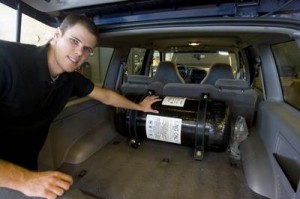Aug
27
Methane (aka natural gas) In Your Tank
August 27, 2008 | 9 Comments
Utah is seeing a “boom” in natural gas i.e. methane fueled automobiles sold and converted from gasoline entering the local fleet. With gasoline still well beyond $3.00 and the local natural gas equivalent at $0.87 the motive is strong. With the incentives from the State of Utah up to $3,000 for a new vehicle and $2,500 for conversions the cost is within reach for many. And many there are, some not so carefully converted.
Imagine pulling into fill up and smelling the vapors of natural gas in the cabin of the car nearby. Gasoline is dangerous enough, and for decades the manufacturers have installed good quality tanks in cars so smelling gasoline leaks is true rarity nowadays. But Utah is experiencing a rash of home conversions done one presumes from better than professional installation down to car sized grenades. One local news site, The Salt Lake Tribune has a piece about the issue, which reveals the lack of good data about the real number of vehicles in the area using compressed natural gas fuel.
The state tax credit is getting claimed by motorists by the hundreds. However the local utility Questar is holding data that the nonprofit Utah Clean Cities Coalition says equals 20,000 vehicles. The Questar natural gas sales have increased some 401 percent over 18 months according to the representative Chad Jones. But the news report is just too vague to make any judgment on the nonprofit’s claim. One thing is certain; the fuel sales growth is closing in on 200% year on year. Some folks are saving a bunch of money in Utah.
This local phenomenon gives more than a little credence to T. Boone Pickens thought that wind can displace natural gas to be used as a motor fuel. The good and somewhat frightening thing is that conversions are possible, even by the back yard mechanic. That and the impression that the North American natural gas market is going to get serious growth leads one to think that there is good potential in natural gas or methane for powering your car.
Now in Utah natural gas is cheap, it’s locally produced by Questar who is a regulated utility so the profit is a one-stop thing from well to car. The conversion itself isn’t highly challenging, but requires more than the know-how for tune-ups as the vehicle is modified either as a converted fuel from gasoline or a dual fuel meaning the gasoline system remains intact for extended range beyond the local compressed natural gas fueling system. In either case the added tank has to go somewhere, safely battened down and connected by lines and connections suitable for petroleum under high pressure. One other big problem is that most any converted car is going to have a sizable chuck of its interior space committed to a large tank for high-pressure gas. Training for this is an extremely good idea.
Now for the true bug in the salve. The EPA, as in the federal agency with horrifying powers and the willingness to use them, has jurisdiction. The word is – I am summarizing some pieces I’ve read with no due diligence on my part – that the EPA expects each car individually to prove it is not polluting more after a conversion than before. It’s thought – no proof here – that some kits and some installers have the resources to get a car legal from a conversion. You are on your own here if going for it.
If you’re not put off now, congratulations, as there are some very sizable benefits to a methane fuel. Even though the tank must grow or the vehicle range be reduced the costs for fuel are going to be lower. How much lower is a question you want to have worked out beforehand. At $0.87 in Salt Lake you would think that the Dallas Fort Worth area would also be dirt cheap, but its not. Oklahoma is though. Just be sure you have the math worked out in front and if needed a home compressor factored into the capital expense.
The engine can last much longer; the low carbon density of methane offers none of the components of common gasoline, which is actually a combination of an array of heavier hydrocarbons. Some of those aren’t really stable over time, which is where the carbon, gum and varnishes come from that drive up maintenance costs. Methane is a good if not very dense motor fuel.
This is going to run into the thousands of dollars. But it can be made to work; there are a lot of fleet and municipal systems out there now. I suggest you consider the switch to be a very long term, multiple car scenario. This would be a commitment of considerable resources that in cases where the local supply is cheap enough can pay off handsomely.
This is sort of an early warning or heads up. I have a certain confidence that T. Boone Pickens is going to make headway and the compressed methane route for fuel is going to have a few good years. It may be much longer than that should the biomass people come up with a cheap process to convert biomass carbon back to hydrocarbon in methane form. This is a crack in the gasoline monopoly that has both the chicken and the egg thing workin’. Just to throw out another bit for the future – methane is one of the leading contenders for fuel cells too.
Methane is way past being a fuel to watch. It’s time to look into how it might work and the costs to change over.
Comments
9 Comments so far




Hi Brian,
Great Article with interesting point of view. I’m a layman in the subject, hence if you allow me to place a couple of questions on the topic.
1) What’s your reckon on why hasn’t this gas car conversion technology picked-up in other states (besides CA and UT) yet ?
2) Why is this wave different than the 70’s gas conversion frenzy ?
Thanks
Christian Becker
hey wat is da formule for this thingy i need it for my work in school……haha yeah
My cousin recommended this blog and she was totally right keep up the fantastic work!
I was just having a conversation over this I am glad I came across this it cleared some of the questions I had.
Good! Thank you! I always wanted to write in my site something like that. Can I take part of your post to my blog?
Interesting read, perhaps the best article iv’e browse today. We learn everyday cheers to you!
Great read. Thanks for the info!
Intriguing post. I have been searching for some good resources for solar panels and discovered your blog. Planning to bookmark this one!
Very eneгgetic blog, I loved that bit.
Will there be a part 2?